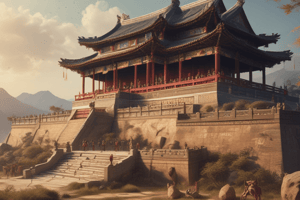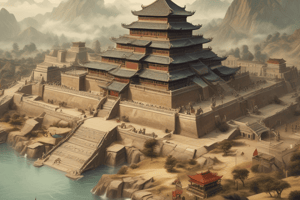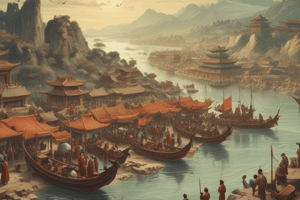Podcast
Questions and Answers
Thời gian trị vì của triều đại nhà Chu kéo dài từ năm nào đến năm nào?
Thời gian trị vì của triều đại nhà Chu kéo dài từ năm nào đến năm nào?
- 1066 – 256 TCN
- 1020 – 300 TCN
- 1100 – 256 TCN
- 1046 – 256 TCN (correct)
Triều đại nhà Chu là triều đại nào trong lịch sử Trung Quốc?
Triều đại nhà Chu là triều đại nào trong lịch sử Trung Quốc?
- Triều đại thứ ba
- Triều đại đầu tiên
- Triều đại thứ hai (correct)
- Triều đại thứ tư
Điều gì nổi bật trong triều đại nhà Chu?
Điều gì nổi bật trong triều đại nhà Chu?
- Sự thống nhất lãnh thổ dưới một triều đại
- Sự xâm lược từ các nước láng giềng
- Sự phát triển của nền văn hóa và triết học (correct)
- Sự xuất hiện của đế chế Mongol
Triều đại nhà Chu tồn tại trong khoảng thời gian bao lâu?
Triều đại nhà Chu tồn tại trong khoảng thời gian bao lâu?
Điều gì không phải là đặc điểm của triều đại nhà Chu?
Điều gì không phải là đặc điểm của triều đại nhà Chu?
Flashcards
Nhà Chu
Nhà Chu
Nhà Chu là một triều đại trong lịch sử Trung Quốc, tồn tại từ năm 1046 TCN đến năm 256 TCN.
Chu Tây và Chu Đông
Chu Tây và Chu Đông
Nhà Chu được chia thành hai giai đoạn: Chu Tây và Chu Đông.
Chu Tây
Chu Tây
Chu Tây là giai đoạn nhà Chu nắm quyền kiểm soát chính trị và quân sự, được gọi là "Thiên tử".
Chu Đông
Chu Đông
Chu Đông là giai đoạn nhà Chu mất quyền kiểm soát, các chư hầu nắm quyền.
Signup and view all the flashcards
Vai trò lịch sử của nhà Chu
Vai trò lịch sử của nhà Chu
Nhà Chu là một trong những triều đại quan trọng nhất trong lịch sử Trung Quốc, đánh dấu sự phát triển của văn hóa và xã hội Trung Quốc.
Signup and view all the flashcardsStudy Notes
Dynasty Overview
- The Zhou dynasty (1046–256 BCE) was a significant period in Chinese history, lasting over 790 years.
- It marked a transition from the Shang dynasty and laid the foundation for much of later Chinese culture and political thought.
- The Zhou dynasty is traditionally divided into two periods:
- Western Zhou (c. 1046–771 BCE): Characterized by a strong central government and a hierarchical social structure.
- Eastern Zhou (c. 771–256 BCE): Further divided into the Spring and Autumn period and the Warring States period, witnessing increased political fragmentation and warfare.
Political Structure
- Initially, the Zhou established a feudal system. Kings granted land and authority to loyal nobles in return for military service and tribute.
- This system eventually weakened as the power of regional lords grew, leading to conflicts.
- The concept of the Mandate of Heaven played a critical role in justifying Zhou rule. The dynasty claimed legitimacy from Heaven, suggesting that Zhou rulers held power only as long as they governed justly and morally.
- The concept of the Mandate of Heaven later influenced subsequent dynasties in China, with the loss of the mandate often being invoked to legitimize rebellions and dynastic changes.
Social Structure
- The Zhou dynasty maintained a hierarchical structure, with the king at the top, followed by nobles, warriors, farmers, and, lastly, artisans and slaves.
- The emphasis on family and ancestor worship remained important aspects of Zhou society.
- This hierarchical structure had a significant influence on later Chinese social conventions and norms.
Economic Development
- Agriculture was the primary economic activity, contributing the most to the economy. Development of agriculture allowed for greater population growth and prosperity.
- The use of bronze and iron tools became more prevalent during the dynasty.
- The development of trade routes became more prominent. Trade across regions expanded and facilitated the distribution of goods.
Cultural Developments
- The Zhou dynasty saw the flourishing of various forms of art, including bronze casting, pottery, jade carving, and silk production.
- The development of many philosophical and religious schools of thought, like Confucianism and Daoism, took root during the Eastern Zhou period. This period gave birth to influential thinkers whose works continues to be studied today.
- The development of writing systems continued to evolve and become more complex, facilitating documentation and communication across regions. Sophisticated forms of writing became more sophisticated.
Military Influences
- Early Zhou military strength was significantly important for maintaining their rule.
- As regional powers grew and centralized authority diminished, warfare became a dominant feature of the Eastern Zhou period, leading to increased sophistication in military tactics and strategies.
- The constant warfare and political instability impacted every aspect of life during this period, and shaped the eventual rise of a unified China and the characteristics of later imperial administrations.
Decline of the Dynasty
- Gradually, the power of the Zhou kings diminished, while regional lords accumulated more power over time.
- Internal conflicts and external pressures gradually eroded the power of the royal house.
- The Eastern Zhou period ended with the unification of various states by the Qin dynasty.
- The long period of the Zhou dynasty and the diverse experiences that arose within it formed a significant foundation for the development of Chinese society, philosophy, and political structures.
Studying That Suits You
Use AI to generate personalized quizzes and flashcards to suit your learning preferences.




